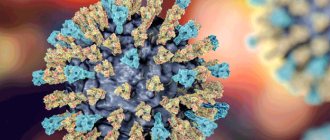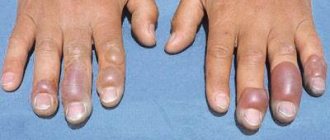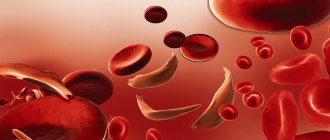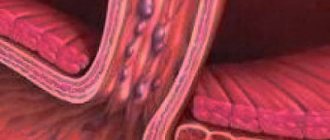Hypovolemia is a pathological condition manifested by a decrease in circulating blood volume, in some cases accompanied by a violation of the ratio between plasma and formed elements (erythrocytes, platelets, leukocytes).
For information, normally in adult women the total blood volume is 58–64 ml per 1 kg of body weight, in men – 65–75 ml/kg.
With hypovolemia, circulating blood volume decreases
Content:
- Causes and mechanism of development
- Classification
- Signs of hypovolemic disorder
- Treatment of hypovolemia
Hypovolemia is a decrease in blood volume with the development of alcohol withdrawal syndrome
. This process occurs due to the recombination of fluid, due to its transition from the venous bed into the cells and the space between them. This phenomenon occurs during the accumulation of toxic substances inside tissues due to dysfunction of the enzyme system, coronary artery disease, and poor functioning of organs. In addition to perfusion problems, a decrease in circulating blood volume (CBV) is manifested by an inadequate ratio of systolic and diastolic blood pressure and a drop in cardiac output. Developing acute pathology is life-threatening and requires immediate medical attention.
Hypervolemia of the pulmonary circulation
The human circulatory system consists of a systemic and pulmonary circulation. The large circle includes vessels that feed all organs and tissues except the vessels that supply the bronchopulmonary system, the small circle includes exclusively the vessels of the lungs.
Distribution of blood in the circulatory system:
- in veins – 70%;
- in arteries – 15%;
- in capillaries – 12%;
- inside the heart muscle – 3%.
Hypervolemia of the pulmonary circulation is based on high pressure in the vessels of the bronchopulmonary system, which is why it is called pulmonary hypertension.
Causes of pulmonary hypervolemia
Factors leading to pulmonary hypertension:
- Reflex narrowing of the small vessels of the lungs. Occurs with severe stress, mitral valve stenosis, embolism.
- Prolonged alveolar hypoxia. Occurs as a result of silicosis, chronic bronchitis, emphysema, obstructive pulmonary disease, anthracnose, bronchiolitis, bronchiectasis.
- Left ventricular failure. Occurs with cardiac arrhythmia, as a result of a heart attack, myocarditis.
- Increased blood density.
- Increased pressure inside the respiratory tract. Occurs with a strong cough, increased barometric pressure of the external environment, and violations of mechanical ventilation.
- Constriction of the blood vessels that drain blood from the lungs. Occurs with aortic aneurysm, tumors, adhesions, and congenital malformations.
- Genetically determined pathology of the enzyme system.
- Increased blood output from the right ventricle.
- Drug intoxication with psychostimulants.
- Infection with the AIDS virus.
- Portal hypertension. Causes: liver cirrhosis, Budd-Chiari syndrome.
- Apnea, or stopping breathing during night sleep due to snoring.
In addition to the factors described above, there are also idiopathic (unknown) causes leading to primary pulmonary hypertension.
Signs of pulmonary hypervolemia
The primary stage of the disease may go unnoticed by the patient. When the symptoms of a disease clearly indicate the presence of dangerous changes, most often the process is far advanced and irreversible.
Signs of pathology:
- shortness of breath, turning into suffocation with increasing load;
- asthenia, its symptoms: insomnia, weight loss, decreased performance, instability of mental state;
- fainting on exertion;
- dizziness;
- severe cough without sputum production, in advanced cases with hemoptysis;
- heart pain;
- progressive cyanosis;
- arrhythmia;
- pain in the projection of the liver.
Diagnosis of pulmonary hypervolemia
Diagnosis of the disease is based on its clinical picture, laboratory and instrumental research data:
- Electrocardiogram (ECG) - helps to identify right ventricular hypertrophy, heart attack, heart rhythm disturbances, pulmonary embolism;
- Chest X-ray - helps in the last stages of the disease to identify increased vascular patterns, hypertrophy of parts of the heart muscle;
- Computed tomography with contrast is an extremely informative study of the condition of the heart and blood vessels;
- Ultrasound of the heart - helps to diagnose congenital anomalies, hypertrophy of the heart muscle, and clarify indicators of vascular blood flow;
- Catheterization of the pulmonary trunk in combination with the introduction of a sensor inside it allows you to measure the pressure in the vascular system of the pulmonary circulation, diagnose or exclude pathology.
Treatment of pulmonary hypervolemia
The main direction of therapy for pathology is eliminating the cause that caused it, since hypervolemia is not an independent disease. Pulmonary hypervolemia is provoked by pathological processes occurring in various systems of the human body. Primary hypertension is the most difficult to treat, since its cause has not been established and the source of negative symptoms is unknown.
In the treatment of pulmonary hypervolemia, drugs and methods used in standard treatment regimens for arterial hypertension are used. If the effectiveness of antihypertensive treatment decreases, Eufillin and oxygen therapy are used.
Author of the article:
Education: Moscow State Medical and Dental University (1996). In 2003, he received a diploma from the educational and scientific medical center for the administration of the President of the Russian Federation.
‹
10 ways to relieve stress
5 best recipes for nail fungus
›
Reasons and mechanism of formation
The pathological hypovolemic process is based on severe dehydration.
Leads to it:
- Vomiting, characteristic of withdrawal syndrome after binge drinking.
- Diarrhea, with the help of which the body cleanses itself of alcohol toxins.
- Liver diseases characteristic of alcoholism (toxic hepatitis and cirrhosis). In this case, non-functional leakage of plasma into the intercellular space occurs due to a decrease in the oncotic pressure of the blood.
- Insufficient intake of fluid and protein into the body.
Hypovolemia is preceded by increased venous and hydrostatic pressure in small arteries, reflecting the negative influence of factors predisposing to a painful condition. Secondarily, the permeability of the vascular wall increases. Sweating of blood through arteries and veins leads to its general deficiency.
The body tries to compensate by:
- Producing the required amount of plasma.
- Slowing venous return.
- Spasms of small vessels.
The protective reaction allows you to maintain the activity of the brain and heart in a relatively normal state for some time and avoid circulatory complications.
Pathogenesis
Hypovolemia of any type leads to a compensatory hemodynamic reaction. The resulting deficiency of circulating blood volume causes a decrease in plasma volume and venous return, as the cardiac and pulmonary veins are fixed and sympathetically mediated vasoconstriction occurs. This protective mechanism allows you to maintain blood circulation for brain and cardiac activity.
Severe hypovolemia reduces cardiac output and thus reduces systemic blood pressure. This reduces blood supply to tissues and organs.
Blood pressure is normalized due to increased venous return, cardiac contractility and heart rate, as well as increased vascular resistance due to increased secretion of renin by the kidneys and the sympathetic effect.
With a mild degree of decrease in blood volume, activation of the sympathetic nervous system, accompanied by slight tachycardia, is sufficient to bring blood pressure back to normal.
In severe hypovolemia, vasoconstriction is more pronounced due to the influence of the hormone angiotensin II and the activity of the sympathetic nervous system. This hormone helps maintain blood pressure in a supine position, but when changing position, hypotension may appear (manifested by dizziness).
Sustained fluid loss during severe hypovolemia leads to severe hypotension even in a supine position. Shock may develop.
Classification
The types of hypovolemia that doctors of different specializations have to deal with have several options. They are due to the dependence of the ratio of plasma and blood elements (hematocrit).
On this basis, the following types of violations are distinguished:
- Normocythemic.
The volume is reduced with a normal hematocrit number. - Oligocythemic.
The amount of plasma is not changed, and blood cells are small. - Polycythemic.
BCC is low, and hematocrit, on the contrary, is high.
Narcologists most often encounter the polycythemic variant. This is what characterizes intoxication with severe vomiting and diarrhea.
To prescribe therapy, the doctor also needs to find out whether the patient has absolute
, or
relative
hypovolemia. Therefore, when making a diagnosis, the doctor examines the patient very carefully, analyzes data from laboratory tests and other special diagnostic methods. This information is required to adjust therapy.
Absolute hypovolemia
occurs against the background of blood deficiency in the vascular bed. It develops due to loss of plasma and lack of fluid intake into the body. In this case, the urinary system works normally.
Relative hypovolemia
characterized by sweating of the liquid part into the intervascular space of the body. Against this background, the BCC remains normal, or even higher than normal values. This condition is also a manifestation of toxic syndrome in alcoholism.
Diagnostics
The diagnosis and degree of hypovolemia is made based on clinical symptoms.
Normally, in adult women, the total blood volume is 58–64 ml per 1 kg of body weight, in men – 65–75 ml/kg.
The scope of laboratory and instrumental studies depends on the nature of the pathology that led to a decrease in the volume of circulating blood. Mandatory minimum includes:
- determination of hematocrit;
- general blood analysis;
- blood biochemistry;
- general urine analysis;
- determination of blood group and Rh factor.
To diagnose hypovolemia, hematocrit is determined and other laboratory and instrumental studies are performed.
If hypovolemia caused by bleeding into the abdominal cavity is suspected, diagnostic laparoscopy is performed.
Signs of hypovolemic disorder
Symptoms of the disorder depend on its severity.
In the practice of narcology, the following stages of hypovolemia are distinguished:
- Easy.
Minor fluid losses (up to 20% of bcc) are accompanied by a decrease in blood pressure, increased heart rate 10-15 beats higher than normal, and slight shortness of breath. The patient is pale, complains of weakness, dry mucous membranes, dizziness, and attacks of nausea. - Average.
The patient loses up to 40% of his total blood volume. In this case, the pressure is sharply reduced (below 90 mm Hg) and the pulse is above 120-130 beats per minute. Breathing is sharply rapid and intermittent. Externally, pallor and cyanosis of the skin in the area of the nasolabial triangle are revealed. There is severe sweating, lethargy, and decreased urine output due to severe thirst. - Heavy.
With a large-scale decrease in blood volume (above 40%), a critical drop in blood pressure is detected. The pulse is barely detectable and reaches 150 or more beats per minute. No urine is released. The patient's appearance indicates that he is in critical condition. There is deathly pale skin, a pointed face, sunken cheeks, and an unconscious state.
Loss of BCC is often accompanied by:
- Hypoglycemia
is a serious complication of alcohol withdrawal syndrome. A harbinger of the development of hypoglycemia is any kind of liver disease, a decrease in glycogen reserves, and poor non-caloric nutrition. - Hyponatremia
is a disorder most often found in patients who abuse drinks with low alcohol content (cocktails, beer). In this condition, peripheral edema occurs in combination with hypovolemia. - Hypernatremia
is a condition that occurs with encephalopathy, acute liver failure, and a clear deficiency in the amount of circulating blood. - Hypomagnesemia
is a deficiency of magnesium inside cells in people with alcoholism, regardless of its content in the plasma. The most common symptoms: general weakness of the body and drowsiness. The risk of seizures and heart problems (palpitations) may increase. - Hypokalemia.
In people suffering from alcoholism, as a rule, potassium deficiency is detected in the body, even if its content in the blood plasma is at normal levels. In combination with an overexcited nervous system, the lack of this element leads to irreparable disturbances in the functioning of the heart with a threat to life. Anyone suffering from alcohol withdrawal syndrome is prescribed potassium supplements.
This pathology manifests itself:
- Fatigue quickly.
- Depression.
- Attacks of tachycardia.
- Muscle weakness.
Alcohol withdrawal syndrome
may be accompanied by metabolic acidosis, which occurs due to the accumulation in the body of the breakdown products of alcohol and other substances of pathological metabolism, in the process of tissue hypoxia and respiratory alkalosis.
Forecasts
Foggy. With proper help, or if the pathological process proceeds relatively easily - positive. But decompensation can occur at any time.
The prospects for severe injuries are much worse. Although here everything is ambiguous and depends on the moment of the start of therapy.
Hypovolemia is a syndrome inherent in many dangerous conditions. It is not him who needs to be treated. The main forces should be directed to the fight against the original source. And this must be done as quickly as possible. In this case, there is every chance of recovery without consequences.
Treatment of hypovolemia
The main task of the doctor in treating this pathology is to eliminate the deficit in blood volume.
Additionally required:
- Strengthen the work of the heart.
- Improve oxygen supply to tissues.
- Remove toxins.
- Carry out symptomatic pharmacotherapy for acute disorders.
To achieve these goals, infusion-drip therapy is used.
Depending on the stage of the process, droppers are prescribed containing:
- Crystalloids, isotonic solution and 5% glucose.
- Reamberin, Reosorbilact.
- Dextran solution, Ringer.
- Plasma substitutes.
Cardiac and respiratory stimulants, hepatoprotectors, nootropics, and metabolic agents are added to the droppers.
In particularly severe cases, red blood cells are used and a blood transfusion is performed.
To prevent the development of hypovolemia in alcoholism, timely treatment of this pathology in a drug treatment clinic, psychotherapy, coding and rehabilitation is required.
Possible consequences
There are two main complications: coma and death. Both develop in severe forms of the disorder. In milder cases, the body suffers from constant harmful influences. Strength is being undermined from within. If the problem has existed for a long time, the following violations are likely:
- Ischemic processes in the brain. Risk of stroke.
- Insufficient supply of oxygen to the heart. High risk of heart attack. And in the early stages - ischemic heart disease, angina pectoris.
- Impaired intellectual abilities.
- Severe asthenic syndrome with fatigue and weakness.
Literature:
- Prehospital correction of hypovolemia / O. A. Tsarev; State budgetary educational institution of higher education prof. education "Saratov State. Medical University named after V. I. Razumovsky" Ministry of Health of the Russian Federation. — Saratov: Saratov State Publishing House. Medical University, 2015. - 141 p.
- From symptom to diagnosis: a guide for doctors / Scott Stern, Adam Saifu, Dayne Altcorn. - Moscow: GEOTAR-Media, 2008. - 810 p.
The text was checked by expert doctors:
Head of the socio-psychological service of the Alkoklinik MC, psychologist Yu.P. Baranova, L.A. Serova, a psychiatrist-narcologist.
CAN'T FIND THE ANSWER?
Consult a specialist
Or call: +7 (495) 744-85-28
Call! We work around the clock!











